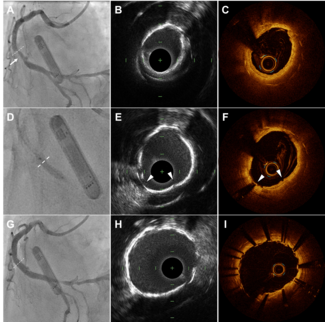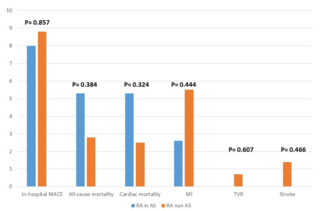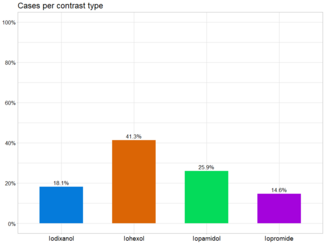Case Report
Spontaneous Dissection of the Left Coronary Tree after an Interruption of Pregnancy Treated with Extensive Stenting
March 2006
Spontaneous coronary artery dissection (SCAD) is a rare cause of acute myocardial infarction and sudden death. It typically occurs in healthy women during the peripartum period or in the presence of connective tissue disorders.1–4 Although the lesion is often fatal and the diagnosis established postmortem, in recent years there have been reports of successful medical, percutaneous and surgical interventions.5 We describe a case of an extensive spontaneous left coronary artery dissection that led to cardiogenic shock and that was successfully treated with multiple stent implantation. It occurred in a young healthy woman on oral contraceptives subsequent to a recent interruption of pregnancy.
Case Report. A 23-year-old female was taken to the emergency room due to the sudden onset of mid-sternal excruciating chest pain that occurred while working at her desk and that lasted 1 hour. She gave no prior history of cardiovascular disease, connective tissue disorders or trauma. She smoked less than 10 cigarettes per day for the last 5 years. Two months before admission, she underwent an elective abortion at 14 weeks and was subsequently placed on oral contraceptive therapy, sequential and monophasic.
An electrocardiogram showed ST-elevation of the precordial leads and of lead I and aVL. On examination, the patient was still complaining of chest pain, shortness of breath and diaphoresis. Her arterial pressure was 80/50 mmHg, and her heart rate 130 beats/minute; heart auscultation revealed an S3 gallop and Killip II congestive heart failure. Shortly thereafter, ventricular fibrillation occurred and was successfully defibrillated with 360 joules. Initial management included intravenous morphine, heparin, dobutamine and lidocaine.
Echocardiography showed severe impairment of the left ventricular contractility (ejection fraction
Discussion. Coronary artery dissection has been described as a complication of aortic dissection, blunt chest trauma, cardiac catheterization, coronary angioplasty or bypass graft surgery.1 SCAD usually occurs in young women, particularly during the peripartum period or in association with oral contraceptive therapy,1,2,6,7 though young men are not spared.8,9 Multiparity seems to be a predisposing factor, whereas no clear association has been found with traditional coronary risk factors, although it has also been observed in young smokers and hypertensive patients.1,5,10 Recently, SCAD has also been decribed in association with prolonged and forceful retching.11 The most frequently involved vessel is the LAD, though left main and multivessel dissections have been described.5 Spontaneous dissection of bilateral internal mammary arterial grafts has also been observed in a single patient.12
The pathogenesis is still unclear and subject to debate. In the peripartum period, there is an altered hemodynamic status with an increase in cardiac output and blood volume, both augmenting the mechanical stress on the arterial wall. Coupled with an adaptive endocrine metabolism, this may lead to smooth muscle cell hypertrophy, loosening of ground substance and fragmentation of reticular fibers. An accumulation of eosinophils, with liberation of lytic proteases in the media, has been shown to contribute to vessel wall damage.2,10,13 Furthermore, excess progesterone has been postulated to induce a weakness in the tunica media by structural modification in the coronary vessel wall.14
Disruption of the vasa vasorum with intramedial hemorrhage and dissection has been found in autopsy studies.15,16 The use of oral contraceptives is also considered a contributor6,7 since high estrogen levels may be responsible for low collagen synthesis and subsequently predisposes women to spontaneous dissection.17,18 In the present case, this condition was present, but it is unclear whether the premature interruption of pregnancy could duplicate normal full-term delivery in terms of endocrine pattern predisposing to SCAD.
To the best of our knowledge, no such case has been previously reported in the literature. In a comprehensive, observational review, Koul et al.5 reported an overall mortality for spontaneous coronary dissections of 38%, mostly occurring within the first few hours from the onset of symptoms. In the surviving patients, various treatment modalities — surgery, angioplasty with or without stent implantation, cardiac transplant and medical therapy — have been shown to be of benefit, with initial high success rates. Medical treatment appears to be appropriate if the patient has no hemodynamic instability and chest pain quickly disappears. In such cases, the dissection occasionally can completely heal, as confirmed by follow-up angiography. Surgical or percutaneous revascularization is mandatory for patients with persistent or recurring symptoms, since the 3-year mortality rate in this setting for the untreated patients is 20%.5,19
Of a total of 58 cases with SCAD reported by Koul, there were 14 patients with left main involvement; of these, 5 (35.7%) died, 4 suddenly or soon after the onset of symptoms, and 1 after a massive medically treated acute myocardial infarction. Interestingly, the 8 survivors were either sent on to CABG (4 patients), surgical extrusion of the hematoma (1 patient), cardiac transplant (3 patients) or stenting (1 patient), and were treated from 1989 on.5
Our case represents the second reported patient with left main and bifurcation involvement treated with stenting. Thrombolysis is relatively contraindicated in patients with SCAD because, although it has been shown to lyse the thrombus in the false lumen, it may also increase the parietal hemorrhage and further extend the dissection.5 At presentation, our patient was in cardiogenic shock, thus an aggressive therapeutic approach was mandatory. Thrombolytic treatment is not considered a first-line choice because of the risk of increasing intraparietal hemorrhaging and so forth, extending the dissection.20 Our report underlines the crucial importance of maintaining a high degree of suspicion for SCAD.
A coronary angiography and complete revascularization had to be performed in order to offer our patient a favorable outcome. CABG could have been an option but, in the setting of acute myocardial infarction with shock, it has high operative mortality and complications.21–23 Moreover, it has been shown to be associated with poorer results in cases of dissected coronary arteries.24–25 The time required to have the surgical suite ready, particularly in off-hours, is certainly much longer than that required to perform ad hoc angioplasty.
The entire dissection was stented in order to stabilize the extensively damaged coronary segments. Although such extensive stenting increases the risk of subacute thrombosis and restenosis, the main goal of the procedure was to quickly stabilize and effectively reverse the patient’s life-threatening hemodynamic status. The observation of a totally occluded ostial LCx after 2 months supported the presence of a coronary thrombus or exaggerated remodeling. We decided to be conservative and wait at least until the 6-month follow up when the other stented segments may have restenosed.
In that case, percutaneous intervention could have been a bridge to delayed surgical revascularization. The 8-month coronary angiography, showing recanalization of the previously occluded LCx, confirmed our first hypothesis of a subacute stent thrombosis associated with neointimal hyperplasia. Considering the absence of symptoms and signs of ischemia, it was felt that further intervention was unnecessary and potentially hazardous because of the risk of involving the left main and proximal LAD. The later occurrence of a further dissection in another section of the patient’s coronary tree also points to the causative mechanism of a genetic disorder of the extracellular matrix organization, such as lysyl oxidase (LOX) deficiency,26 which we were not able to investigate in our patient at that time.
An aggressive diagnostic approach is warranted also in young women on oral contraceptives who present with acute coronary syndromes and who have had an elective or spontaneous abortion. An interventional procedure, particularly primary stenting, should nowadays be considered the first therapeutic option in patients with suitable anatomy. Premature interruption of pregnancy followed by oral contraception should be added to the list of clinical profiles associated with SCAD. The risk of coronary dissection may extend beyond the trigger event due to some not yet well-known alterations in the connective tissue of some SCAD patients.
Acknowledgment. We wish to acknowledge Dr. John Lasala of the George Washington University in Saint Louis, Missouri, for his thoughtful revision of the manuscript.
1. Hurst JW. Hurst’s The Heart. Arteries and Veins. (8th Ed.). New York: McGraw Hill, 1994, p. 1349.
2. Rabinowitz M, Virmani R, Mcallister HA Jr. Spontaneous coronary artery dissection and eosinophilic inflammation: A cause effect relationship. Am J Med 1982;72:923–928.
3. Elkayam U, Rose J, Jamison M. Vascular aneurysm and dissection during pregnancy. In: Elkayam U and Gleicher N, (Eds.). Cardiac Problems in Pregnancy: Diagnosis and Management of Maternal and Fetal Disease (2nd ed.). New York: Alan R. Liss, Inc. 1990, p. 215.
4. Movsesian MA, Wray RB. Postpartum myocardial infarction. Br Heart J 1989;62:154–156.
5. Koul AK, Hollander G, Moskovitz N, et al. Coronary artery dissection during pregnancy and the postpartum period: Two case report and review of literature. Catheter Cardiovasc Interv 2001;52:88–94.
6. Basso C, Morgagni GL, Thiene G. Spontaneous coronary artery dissection. A neglected cause of acute myocardial ischemia and sudden death. Heart 1996;75:451–454.
7. Azam MN, Roberts DH, Logan WFWE. Spontaneous coronary artery dissection associated with oral contraceptives use. Int J Cardiol 1995;48:195–198.
8. Smith JC. Dissecting aneurysms of coronary arteries. Arch Pathol 1975;99:117–121.
9. Corsini G, Fattore L, Romano S, et al. Dissezione spontanea di due rami coronarici in un giovane maschio. Descrizione di un caso clinico. Ital Heart Journal Suppl 2002;3:225–228.
10. Barret JM. Pregnancy related rupture of arterial aneurysm. Obstet Gynecol Surv 1982;37:557–556.
11. Velusami M, Fisherkeller M, Keenan ME, et al. Spontaneous coronary artery dissection in a young woman precipitated by retching. J Invasive Cardiol 2002;14:198–201.
12. Qaddour A, Roongsritong C. Spontaneous dissection of bilateral internal mammary arterial grafts. J Invasive Cardiol 2002;14:207–208.
13. Dowling GP, Maximilian Buja L. Spontaneous coronary artery dissection occurs with and without periadventitial inflammation. Arch Pathol Lab Med 1987;111:470–472.
14. Madu EC, Kosinski DJ, Wilson WR. Two-vessel coronary artery dissection in the peripartum period. Angiology 1994;45:809–816.
15. Thayer J, Healy R, Maggs P. Spontaneous coronary artery dissection. Ann Thorac Surg 1987;44:97–102.
16. Bulkley B, Roberts W. Isolated coronary artery dissection. J Thoracic Cardiovasc Surg 1978;67:148–151.
17. Heefner WA. Dissecting hematoma of coronary artery. JAMA 1973;223:550–551.
18. Bonnet J, Aumaillwy M, Thomas D. Spontaneous coronary artery dissection: Case report and evidence of defect in collagen metabolism. Eur Heart J 1986;7:904–909.
19. Braunwald E. Heart Disease: A Textbook of Cardiovascular Medicine (5th Ed.). Philadelphia: WB Saunders, 1997, p. 1349.
20. Zupan I, Noc M, Trinkaus D. Double vessel extension of spontaneous left main coronary artery dissection in young women treated with thrombolytics. Catheter Cardiovasc Interv 2001;52:226–230.
21. Hochman JS, Sleeper LA, Webb JG, et al. for the SHOCK Investigators. Early revascularization in acute myocardial infarction complicated by cardiogenic shock. Should we emergently revascularize occluded coronaries for cardiogenic shock. N Engl J Med 1999;134:625–634.
22. Hochman JS, Sleeper LA, White HD, et al. for the SHOCK Investigators. One-year survival following revascularization for cardiogenic shock. JAMA 2001;285:190–192.
23. Webb JG, Sanborn TA, Sleeper LA, et al. Percutaneous coronary intervention for cardiogenic shock in the SHOCK Trial Registry. Am Heart J 2001;141:964–970.
24. Almahmeed WA, Haykowski M, Boone J, et al. Spontaneous coronary dissection in young women. Cathet Cardiovasc Diagn 1996;37:201–205.
25. De Maio SJ Jr, Kinsella SH, Silverman ME. Clinical course and long term prognosis of spontaneous coronary artery dissection. Am J Cardiol 1989;64:471–474.
26. Sibon I, Sommer P, Daniel Lamaziere JM, Bonnet J. Lysyl oxidase deficiency: A new cause of human arterial dissection. Heart 2005;91:e33.


















